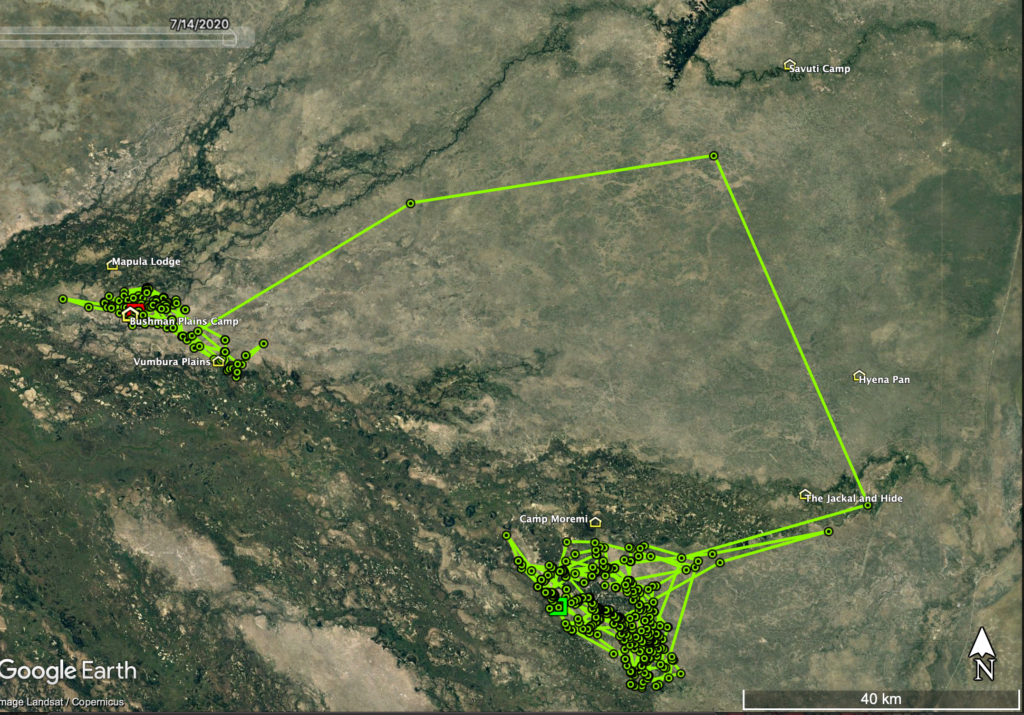Over the past few years, as part of a collaborative effort between the University of Zurich (Switzerland) and the Botswana Predator Conservation (BPC) and supported by the Botswana Department of Wildlife and National parks, we have equipped dispersing African wild dogs with GPS/Satellite radio collars. The aim of the project is (i) to follow dispersers after emigration from the natal group and to investigate the effect of landscape characteristics on dispersal distance, time and movements, and (ii) to gather crucial demographic parameters such as mortality rate, settlement success, and reproductive success after settlement in a new territory.
Recently, an unusually large coalition of eight brothers born in 2018 has emigrated from their natal pack inhabiting the Third Bridge – Budumtau – Xini region of Moremi Game Reserve. Thanks to the GPS data regularly sent to a base station via the Iridium satellite system, we have been able to remotely follow their movements. After emigration, they covered over 175 km in only five days before hitting the permanent swamp that surrounds the Kwedi Concession in the northern side of the Okavango Delta. During the past month they have been stationary in an area of about 180 km2 stretching between Vumbura Plains Lodge and Mapula Lodge. But dots on a map represent only a small part of the story… Are the eight brothers still together or have they split? What have they been doing? Have they met unrelated females and formed a new pack?
Figure: Movement trajectory of a dispersing coalition of eight male African wild dogs
Despite the collar sends us regular information, keeping up with the dogs over such large areas is almost impossible, unless we can capitalize on “the many eyes out there”. Tourists, guides, camp managers, all can contribute with their sightings towards research. No sooner said than done. We informed people at the lodges about the presence of the dogs in their area and asked them to report of any sighting and to send as many pictures as possible. Just a few days later we received the first information: a group of 9 dogs, including a collared dog, had been seen a few kilometres north of Vumbura Plains by the lodge staff. The pictures allowed identifying five of the original eight males and four unknown females. As expected, the males had indeed split and three brothers had probably gone a separate way. Or had they died during dispersal? An answer to the question arrived just a week later when a second sighting of 12 dogs was reported to us near Bushman Plains camp. Again, thanks to the pictures sent to us, we were able to identify the three missing brothers, who had clearly not died, among the 12 dogs. Future sightings will tell if this newly formed pack composed of 12 dogs will remain together or if some individuals will spin off (process known as secondary dispersal) searching for new mates with whom to build the own pack. But why would some undergo the risks of a second dispersal? Well, because of the eight males and four females only one of each sex will become dominant and reproduce. The others who will remain will help raise future pups but won’t directly reproduce. Therefore, some dogs may decide to take on the extra risk and continue dispersing. Bets are open, and chances are that the three brothers will part again. Time, and your sightings (!), will tell.
We, researcher, can benefits from any report and sightings, as it has been the case here. In return will be able to centralize all information and put together all pieces of the puzzle to share our knowledge with policy makers, stakeholders, and the tourism industry.
Please, keep sharing your sightings with us, of both collared and non-collared individuals, to help us protecting these amazing animals.

